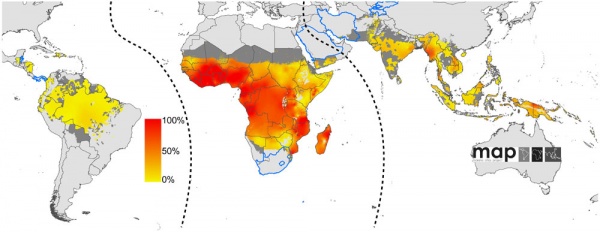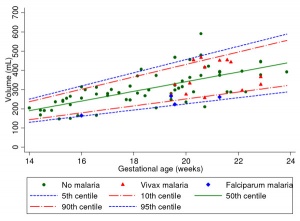Abnormal Development - Malaria: Difference between revisions
No edit summary |
|||
| Line 24: | Line 24: | ||
|} | |} | ||
[[ | [[Talk:Abnormal_Development_-_Malaria|Recent References]] | [[#References|References]] | ||
===Placental Malaria=== | ===Placental Malaria=== | ||
Pregnant women have an increased susceptibility to malaria infection. Malarial infection of the placenta by sequestration of the infected red blood cells leading to low birth weight and other effects. | Pregnant women have an increased susceptibility to malaria infection. Malarial infection of the placenta by sequestration of the infected red blood cells leading to low birth weight and other effects. | ||
Revision as of 13:27, 7 February 2013
Introduction
About 10,000 women and 200,000 babies die annually because of malaria in pregnancy, which can cause miscarriages, preterm births, and low-birth-weight births.[1] There are about 156 species of Plasmodium which infect different vertebrate species. In humans there are four types of malaria caused by the protozoan parasite Plasmodium falciparum (main), Plasmodium vivax, Plasmodium ovale, Plasmodium malariae.
Placental infection is common in regions where malaria is endemic with women carrying their first pregnancy (primigravida).

|
| Global limits and endemicity of P. falciparum in 2007 |
Some Recent Findings
|
Recent References | References
Placental Malaria
Pregnant women have an increased susceptibility to malaria infection. Malarial infection of the placenta by sequestration of the infected red blood cells leading to low birth weight and other effects.

- Several infective agents may cross into the placenta from the maternal circulation, as well as enter the embryo/fetal circulation. \
- Pregnant women have an increased susceptibility to malaria infection.
- Malarial infection of the placenta by sequestration of the infected red blood cells leading to low birth weight and other effects.
References: Beeson JG, Duffy PE. The immunology and pathogenesis of malaria during pregnancy. Curr Top Microbiol Immunol. 2005;297:187-227. | Brabin BJ, Romagosa C, Abdelgalil S, Menendez C, Verhoeff FH, McGready R, Fletcher KA, Owens S, D'Alessandro U, Nosten F, Fischer PR, Ordi J. The sick placenta-the role of malaria. Placenta. 2004 May;25(5):359-78.
Links: Brown University - Maternal Malaria | CDC - Malaria
References
Bookshelf
Bioinformatics in Tropical Disease Research: A Practical and Case-Study Approach Gruber, Arthur; Durham, Alan M.; Huynh, Chuong; del Portillo, Hernando A., editors Bethesda (MD): National Library of Medicine (US), NCBI; 2008 Control of Gene Expression in Plasmodium
Reviews
Articles
Search PubMed
Search Pubmed: Placental Malaria
External Links
External Links Notice - The dynamic nature of the internet may mean that some of these listed links may no longer function. If the link no longer works search the web with the link text or name. Links to any external commercial sites are provided for information purposes only and should never be considered an endorsement. UNSW Embryology is provided as an educational resource with no clinical information or commercial affiliation.
- CDC Division of Parasitic Diseases and Malaria Malaria
Glossary Links
- Glossary: A | B | C | D | E | F | G | H | I | J | K | L | M | N | O | P | Q | R | S | T | U | V | W | X | Y | Z | Numbers | Symbols | Term Link
Cite this page: Hill, M.A. (2024, April 20) Embryology Abnormal Development - Malaria. Retrieved from https://embryology.med.unsw.edu.au/embryology/index.php/Abnormal_Development_-_Malaria
- © Dr Mark Hill 2024, UNSW Embryology ISBN: 978 0 7334 2609 4 - UNSW CRICOS Provider Code No. 00098G
